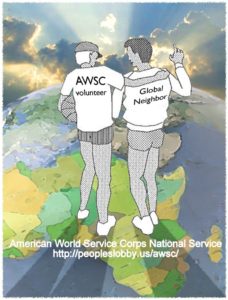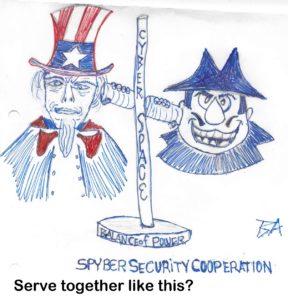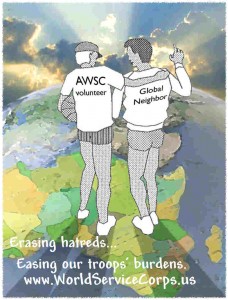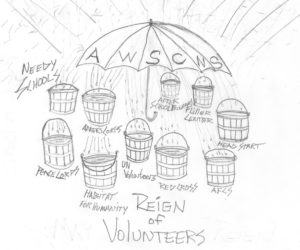Inklings from India
DWAYNE HUNN

“Seek to imitate… our Master, who when he sees a poor man does not wait for him to beg for alms.” — Khun Boron
Here and There: Problems of Quality
Stay with me for some of my next few words as they walk down a street for you. After walking down this street I will attempt to become, in some way, analytical about the world that street lies in, and about our world’s relation to it. Both worlds are very important, although and because, their way of thought and motivation are different.
Try to imagine that you and I are on the corner of that street. Trust me to guide you down it and view it to you as I feel you would. Trust me, because I lived on that street for ten months and viewed it as many times as you probably would on this paper.
The corner is a busy intersection jerkily flowing with small cars, an occasional rich man’s Chevrolet, two-tired and dilapidated red buses, bicycles, and carts of all sizes
—all laboriously pushed by thinly sinewed, dark skinned legs. The restaurant on the corner, with the walls opened to the street, makes edible curry. Edible, once you have gone through the initial stages of dysentery due to the initial eatings of it. The overhead fans do little to keep flies off your food. The etiquette of the waiters, who carry six glasses of water at once by inserting their fingers into the innards of the glasses, leaves a little to be desired. Carrying the water glasses as such is not too bad, but when the waiter cleans leftovers from the dishes, blows his nose in his fingers and then brings the glasses—then, more than etiquette enters in. Passing the restaurant, we edge around the queue (line of people) which winds down the sidewalk. They have queued-up to receive their vegetable oil allotment. The third little shack dispenses it. The short squat man lying in the shack on a raised portion of wood is the proprietor. He lies there with his white clothes and contented smile almost daily. He does not seem to do much else. Others do it for him. We have passed the last of the little shops. They were selling articles from soap and materials, to flashlights and lamps. All domestically made articles—this is the poorer area of the city.
Perhaps along with our visual conceptions a little socio-economic background would aid our journey. The housing area we are now entering is one of the areas commonly termed the chawls. The chawls are India’s slum tenements. Here, a few hundred thousand of Bombay’s one to three million chawl dwellers reside.
Continuing down the street our senses take in the new and unexpected. But the sense mechanism is so flooded—shocked may be a better word—that initially it is impossible to express. But we do notice the obvious. The air of the street is filled with dirt, vehicle exhaust and the stench of dirty humans, garbage and excrement. But that is merely the air. Breathing this, we proceed down the street. We proceed slow-jostled and stepping between all the little people on the sidewalk makes movement such. We become impatient with the overflow crowd of the sidewalk and move to the street. There, part of the overflow crowd, we compete with vehicles for movement. On the curb of the sidewalk we have just left are little, weary Indian women commonly called “vegetable wallahs.” They sit on a little hemp sack with their income for the day, or week beside them. That income may consist of 40-50 small potatoes stacked, ready for sale, in piles of four. Moving in the street through the foul air and crowd our ears soon become attuned to the honks and screeches of passing vehicles, the call of vegetable wallahs, the clatter-chatter of the crowd, the wails of children and the blare of Hindi music. Looking through the crowd we can see into the room of a dirty grey, four-storied chawl. Through the barred window, we can see that pots, rags, pictures of holy men and very often a picture of President Kennedy adorn the meager wall space. The room we have looked into has that one barred window, one door and no fan. It is 15’x12’ and is home for usually 6-12 joint family members.
Outside the barred window lies a 20’ separation before the next chawl begins. That space is littered with dirt, rocks, glass, red Indian spittle, excrement and garbage. Mound the numerous large piles of garbage, dining cows and/or pigeons will be found at any time of the day. At night rats in large numbers will be found. Rats in Bombay are estimated at between 5-12 per person. Occasionally during the day, a person will be seen scavenging a similar pile of garbage. Hard to believe, but very true. No Diners Card needed for this club.
Returning to the curb our view focuses on a ten-month-old child of one of the vegetable wallahs. The mother keeps the child with her since the rest of her family is out trying to earn a few paises (like a penny). The child adjusts to the environment, she must. The naked child crawls off the hemp mat and as it does so you notice the large sores around the pelvic area. Medicare? No, not even Johnson’s Baby Powder is available.
One observant walk down such a street is unforgettable. Many walks—and especially living there—brings home the vicious circle of the meager life, education, and experience these people are forced through. The crowded and dirty living conditions put health, privacy and enjoyment at a bare minimum. Their food staples, rice and dahl, are severely rationed and spreading it to a joint family keeps that family frail and weak. During the school year, the children get out of this environment six times a week—to be educated. They go to half day classes which average between 35-50. Teachers are not well paid or well trained, and the environmental background speaks for itself. With this classroom setting, rote memory, with next to no creative formation is the method.
At birth these children were as cute as, and their eyes sparkled, as much as any American counter part. But soon enough their eyes assumed a hollow, weak look. A Middle class American baby gets, and soon enough learns to expect, much different treatment.
Incidentally, what we just walked through is how the upper lower class lives, the class which borders on the middle class. The one-and-a-half to three million who live in clusters of disgusting hutments and under the skies on the streets are lower.
Peace Corps Reflections, Impressions:
That was a bit of the grass roots description of a RPCV. The Peace Corp is meant to try to affect development on this grass roots level. Sometimes it can, sometimes it must work otherwise. Such was the case with our group. But out of this all of us learned something about the problems which blocked success at this level. At the same time one of our most important educations was one of appreciation for the “so much” we have at home. As an Urban Community Development group, some of us came to India believing we should act as proteges of Saul Alinsky. That we should organize the lower classes, have them petition and/or fight for their rightful, human deserts to the government bureaucracy above them. Yes, the beautifully pyramidal, governmental welfare structure exists—on paper. But to expect redress of life’s grievances from that structure is foolish, and the lower classes have never bothered to feel otherwise.
Being an American in the city also offers opportunities to get to know the upper and middle classes. The middle class has its own environmental hang-ups. They are aware of how the rich live, desire some of their possessions and experiences. Their teenage children are not like the chawl or hutment children—many of which have never been to the downtown, financial, entertainment center of the city. The middle class teenager has seen it, experienced some of it and adds to the family pressure to enjoy more of it. But that costs money. Money comes from position. Appointment does not depend axiomatically on position, but class position plays a very important role in attaining these appointments. For those below the upper class it is usually a hindering role. The economic structure of developing nations adds to the hindrance. The middle-class father would like to have money for a business venture, would like to have connections to aid this and would like to use both to put his children through the good private schools and then through a foreign university. With these status symbols his children’s aspirations will be more attainable than they presently are to him. Father has learned a little through life and has been stuck beneath the bureaucracy long enough to realize the impediments thwarting improvement of his position. He can talk continuously of these problems. He has not yet tired of talking, but has tired of believing—if he ever believed such—that he or anyone can meaningfully change the structure. He is frustrated, but seems to have accepted his position—beat by the structure. India’s political structure offers few immediate, effective changes. Such a structure based on a 75-80% illiterate and peasant populace, supported by ensuing traditional beliefs and continued by a moderate (for Asia—except when imputed on its base) two-point four percent population increase; offers few clear spots in the smog.
A Commitment?
This is but a sketch of the problems of the world’s largest democracy. How does the rest of the free world, and particularly America, aid India with these problems? Proponents of aid would generally agree that it should be directed to developing human and economic resources. Opponents would point out that for 20 years we have aided nations like this yet they have not “taken off.” Their answer is— “therefore taper off.”
Some Human and Economic Thoughts
Patience has not been a particularly American virtue. Perhaps, due to this, some of our successes have come. Yet many of the underdeveloped nations have developed a culture premised on an abundance of patience. To many Westerners this patience seems better defined as indifference or apathy. But they have also had certain bases for this feature which we have not. Many of these nations have had civilizations running into the thousands of years. Perhaps human nature drifts from conservatism, to patience, to indifference through such a span. Many are in energy sapping climates. Due to such factors, they have been left behind in science and technology; and population, in the meantime, has aggravated the human economic situation.
Foreign aid and patience returns this thesis to India. A few facts and figures gives some credence to the belief that perhaps the amount of foreign aid and patience should be tied together.
- S. Economic Assistance Expenditures 1945-65
$ Per capita ( ) Per capita rank
India 11.16 19
Korea 136.88 7
Taiwan 182.07 5
Philippines 39.20 10
For Korea, Taiwan and the Philippines, the U.S. has almost phased out its economic assistance program. These nations are approaching the point where their economic infrastructure should allow them to self-propel their economies. Yet the amount of per capita assistance given them as compared to the world’s largest struggling democracy is strikingly obvious.
The reason for the difference is not solely our policy. In 1945 we were engrossed with containing communism and generous amounts of foreign aid was one of our weapons. India was engrossed with the neutralist ideal directed by the charismatic shadow of a Ghandi. Therefore, the discrepancies in relative aid receipts to various nations are possibly a significant reason for difference in economic development 20 years later.
Money means capital investment, this means more factories, which means more jobs, which means that kid in the chawls may land a job rather than idle in his family’s one room or on the street corner. In India, one facet of America’s aid policy is to pump money creating investment into the hands of the frustrated middle class father, and too, by doing so, aid the chawl kids’ needs also.
The program works something like this. America has supplied India with tremendous amounts of grain in the last few years (11 billion tons last year). Due to India’s precarious foreign exchange condition she has allowed her to repay in rupees. America can not use the rupees anywhere but in India. So, she lends 80% of it back to private entrepreneurs in India. The other 20% is used for the administrative costs of our governmental personnel in India. The amount of rupees owed the U.S. is staggering. Thus, Indian government officials often criticize this “Public Law 480” program as “foreign domination of our economy.” A similar view would probably be espoused by intellectuals here at home who see exploitive motives in most of our giving. In India, the criticism comes from those who feel that either complete centralized planning, and/or complete Indian government control over all economic aid allotments is the answer. The AID position is that private entrepreneurs and their initiative and profit motives are a needed part of the answer, not merely centralized planning. They also feel that over this double loan— which America never really expects to collect—they should have some authority. They also point out that the Indian government has control over the distribution of this money by their process of licensing, which the capital seeker must pass through to gain AID grants. Indian criticism of this PL 480 process, for some of her above reasons, may be part of the answer as to why the rupee repayment is presently being phased out. By 1971 all repayments will be in dollars. ‘Where will she get them?
Business Perspective
Bombay is India’s most booming city. Industry. and construction is going on constantly and everywhere. Calcutta used to be in this position. But she has reached her physical limit. Also, detracting from investment there is the Bengali labor mentality of “gheraos” (strikes—sometimes violent), and general disrespect towards— or self-pride if you interpret it on the Bengali side—toward the Berah Sabh (Big Boss). These two areas are the only real commercial, financial and industrial centers in India. Therefore, they are also the two major tax sources, supplying over 60% of the tax revenue. (An 80% peasant population averaging only- 75 rupees a year is no tax source). India’s tax system, depending on whose stats you use, is either the highest or one of the highest in the world. So, businessmen in either of these cities constantly gripe about the chunk the government takes from them.
Chunks which presumably could go for reinvestment. Even so, the tax system is not leveling the station of the very rich business men. Evasion and inefficient collection keeps these men living in the splendor of contemporary maharaj as.
There is a movement afoot in India which some feel is the answer to India’s problems—alas the world’s! It is called Moral Rearmament and its title is self explanatory. If they were serious, these MRAs would concentrate their efforts on that rich class of businessmen from which many of their parents come. For among these select few there are not enough truly socially responsible individuals. Mr. Tata, the owner of Indian Airlines, Tata Oil and Steel and others, seems to be one of the few, as his wealth is seen spread in institutions to better the lot of those below; especially the Parsee community of which he is one. This lack of social responsibility, which in many ways seems applicable to our affluent, middle class society, will lead into my last comments on a facet of human resource development.
Top
Education and Where It Leads
Bottom
For division’s sake, we could make four qualitative divisions of the Indian school system. In ascending order, the lowest is the village school. This is not based on experience, but merely on reasoned comparisons of the low quality municipal school, and their teacher attraction over that of village school. The second rung is filled by the municipal schools and Catholic orphanages. Then follows the semi-private and Catholic schools. The pinnacle is possessed by completely private schools and especially well-endowed Catholic schools.
Three months ago, the government was talking of replacing these pinnacle schools with neighborhood schools. The language teaching medium, the student quality difference, and the exodus of teachers were some of the problems this would cause. But it is to these schools that the upper-class elite sends their sons and daughters. Chauffeured to and from school, brought warm lunches from home by one of their many servants, placated by most of the teachers due to the power their parents possess—school to these students usually contributes to their spoiled, spineless, undirected qualities. When they are chauffeured through the poverty surrounding them they never think of it as their future responsibility. At this pinnacle only a rare Indian teacher will teach them to be observant, thoughtful and critical. Rote memory, paraphrasing of the textbook and unimaginative homework are the standard methods of education. Athletics provide little in the way of character formation through discipline, sweat and grime. Lack of fields and unaggressive coaching are a major part of the reason. Their vacations, weekends, etc., are spent in air-conditioned homes, restaurants, parties and country clubs. Part-time work they do not think of, probably even if there was a labor market need, which of course there is not. High school graduation, after their keen pursuit of grades for grades sake, will find all seeking studies abroad. Some already with the intent of staying abroad, most unwilling to say but ready and willing to sway to that philosophy. Most feel little patriotism to their country, feel they owe it little and feel it offers them little compared to what is offered elsewhere.
This is the class which is being trained to take over the chairs of its society’s leadership. They can get by with a shallow education—as their success in foreign universities proves. But can their societies of tomorrow get by without feeling the pulse of the masses’ needs below them? Without them feeling responsibility toward those needs? Can they feel that pulse without now becoming more involved, in some small way, by volunteering their time and effort in teaching, building and experiencing the life of the 95 % below them? Are our affluent, middle class students different enough, when the worthy passions of our time seem to be misplaced from constructive civil rights work, headstart programs, etc., to constant good-time parties, uncivil demonstrations, etc?
Those being educated at the pinnacle will inherit the few spots of authority which exist in the political-economic infrastructure of their developing economies. Those in the lower divisions of schools are inferiorly educated, partly due to the environment they live in. They are groomed to fill the dreary, routine jobs. From these jobs, which comprise the bulk of their societies system, an outsider experiences just what their environmental life and rote memory learning situation results in. Almost all of the civil servant employees, firm managers, indigenous engineers, teachers, etc., have been groomed on being told an answer, or on finding it in a book. When situations, which you unfortunately may be the instigator of, present themselves and call for a self-initiated course of action — you are in trouble. You may be left waiting for hours, days or weeks over what by our standards, would be considered an inconsequential act. During this tune one of the above mentioned being dealt with will search policy manuals for the patented answer, or seek higher authority to dodge personal responsibility. It is considered culture when things do not move fast in many Latin American and Asian countries. But today it is part of the weak system of low quality education and thought which seems to be institutionalizing this type of action in those places. Due to the surplus of problems and dearth of resources to deal effectively with this low-quality education system, it becomes more institutionalized and less susceptible to future change.
The upper-class student can thwart the low quality educational system because they have the means to remain near the scientific-technical revolution. They have access to radios, books, travel (though exchange restrictions are forcing many more Indians to remain provincial in their outlooks), etc., with which to stay abreast of the world. In fact, due to the low economic position of the teacher, the students are often more abreast of the modem world than are they. The teaching profession does not attract the better qualified and upper class people. This scale will give an idea why.
Starting Salary
Teacher (municipal) Rs. 64/month
Teacher (private) 180/
Stenographer 250/
Stewardess 400/
Businessman 1000/ up
Thus, if you are especially qualified, you must be very dedicated to pursue this profession.
I could go on. But perhaps enough known problems of India along with a few more complexities, hopefully revealed here, has served a purpose. As most media viewers know, India for the past few years has been in a position of strain. Due to this her political structure is also being strained to reduce the other social strain. The Congress party is no longer monolithic. She is bitingly chastised by the middle class, business dominated Swatantra party, by the wings of the Communist party, by the conservative and often chauvinistic Jan Sang party. The strains and criticisms have focalized many inadequacies and corruptions in India’s means of development. Hopefully this atmosphere will mean a more efficient path to change. But, at this possibly crucial stage, a major change in our foreign policy could be a catastrophe. I can look back to a personal level for enforcement here. Orphans in India go unclaimed for life. Catholic institutions care for them. Yet the price of administration determines the amount of care available. Were it not for the free aid of powdered milk and wheat supplied by the U.S., rice supplied by Spain and canned goods (produced by the U.S.) supplied by Holland; the 150 orphans I worked with would be a smaller and physically weaker number. This goes on through the system, right down to the grains we supply the masses. Granted, much of this is pilfered by men with connections, amazing amounts are eaten by rats (some figures claim 20-25% of the gross supply); but without that amount that trickles down to the rightful, needy sources what would happen? An Indian state commissioner once told me, “If America was really our friend she would cut all foreign aid, leave us to flounder, suffer and face up to our problems alone in our own way.” Their own way would possibly mean a shaking out of their lethargic, apathetic frame of mind. But it would also possibly mean revolution, bloodshed, mass starvation, disease, etc. The experience, if our Western, Christian mentality could sit through the bloody coliseum, would be ugly and inhumane. A consequently ugly, inhumane government could be the result.
The walk through the chawls was ugly. But without our understanding of its life and its causes, our aid and patience in changing these—it could be much uglier. One of my favorite quotes concludes and applies well to India and our relation to it. It concludes and applies just as well to our affluent society’s responsibility to the development of quality at home. Albert Schweitzer once said:
And for those who have more,
Those who need not struggle for existence,
It is for them to set the example.
Phalanx Academic Journal, Edited by William Allen, Claremont Graduate University, 1967










 uty that stalks him on the elevator. Since President-elect Trump likes to tweet, here’s a lovely tweety-bird like Christmas gift that won’t cost you anything and will save bloodshed, expensive military dollars, and heartbreak year-round.
uty that stalks him on the elevator. Since President-elect Trump likes to tweet, here’s a lovely tweety-bird like Christmas gift that won’t cost you anything and will save bloodshed, expensive military dollars, and heartbreak year-round.


